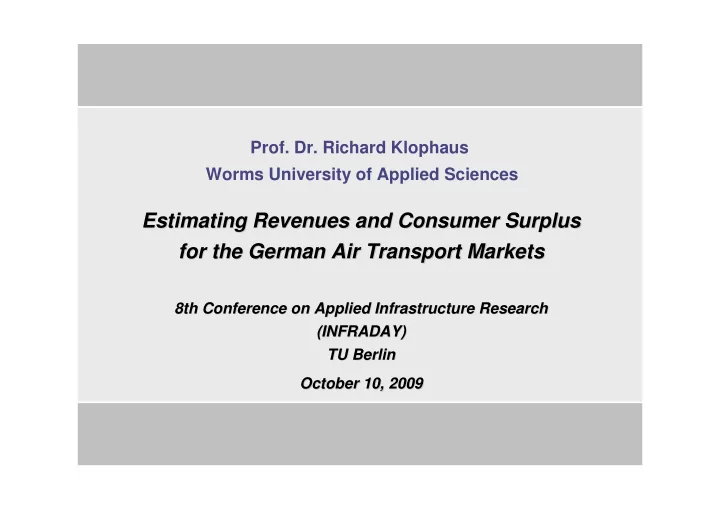

Prof. Dr. Richard Klophaus Worms University of Applied Sciences Estimating Revenues Revenues and and Consumer Surplus Consumer Surplus Estimating for the German Air Transport German Air Transport Markets Markets for the 8th Conference 8th Conference on on Applied Infrastructure Applied Infrastructure Research Research (INFRADAY) (INFRADAY) TU Berlin TU Berlin October October 10, 2009 10, 2009
Key issue How to measure the impact of air transport on economic welfare beyond direct, indirect and induced impacts? Relevant for: � (Further) liberalisation of air transport � Investment in infrastructure (airports etc) � Airport regulation (eg night curfews) � Policy decisions to raise the cost of air transport (eg increase of airport charges, inclusion in emissions trading schemes) 2 Richard Klophaus, October 09
Literature Economic impact of air transport � ACI Europe (2004), The Social and Economic Impact of Airports in Europe � MPD Group (2005), Assessing the Economic Costs of Night Flight Restrictions � Oxford Economic Forecasting (2005), The Economic Catalytic Effects of Air Transport in Europe Air transport demand elasticities � Gillen / Morrison / Stewart (2003) � InterVISTAS Consulting (2007) � Ernst & Young (2007) 3 Richard Klophaus, October 09
Benefits (and costs) of air transport Air transport services (for business passengers, leisure passengers, airfreight, express deliveries etc) Catalytic Impacts Revenues for companies in the air transport industry Employ Earn profits, Buy goods Consumer Economic Environmental own staff and services spillovers pay taxes surplus of and social from suppliers users impacts Direct impacts Indirect impacts Negative Positive eg inward eg outward investment, investment, outbound Workplace counts Spending by employees on inbound Multipliers other goods and services tourism tourism I/O analysis CGE models Induced impacts 4 Richard Klophaus, October 09
Consumer surplus � Consumer surplus as the difference between Price the user‘s willingness to pay and the actual air fare and cargo rate respectively � In theory, consumer surplus is a convincing montary measure of welfare, however, a Supply practical method for implementation is needed Consumer surplus � Requires specification of P* � curvature of demand function, � average (own) price elasticity, Demand � average price and sales volume Quantity Q* of air transport market under consideration 5 Richard Klophaus, October 09
Two illustrative air transport markets Express freight Low cost travel Price Price � Relatively inelastic demand � Relatively elastic demand � High catalytic impact � Low catalytic impact Consumer surplus Supply Supply Consumer surplus P2* P1* Relatively elastic demand Relatively inelastic demand Quantity Quantity Q1* Q2* 6 Richard Klophaus, October 09
Curvature of demand function Only data on average (constant) price elasticities for different air transport markets is available Demand curve with contant elasticity is non-linear, elasticity of linear curve changes from 0 to -infinity Market equilibrium: Air travel demand (Business, short-haul to/from Germany) • 5.2 m passengers • Average fare: 750 € 3.000 2.500 • Price elasticity: -0.8 Airfare (Euro) Linear demand 2.000 1.500 � Linear demand Demand with 1.000 constant elasticity function leads 500 to lower limit of 0 1 2 3 4 5 6 7 8 9 consumer surplus Passengers (million) 7 Richard Klophaus, October 09
Specification of price elasticity estimates � Average own-price elasticities � Varying elasticities for different air transport markets according to degree of necessity and distance � National level elasticities, no consideration of differences between outgoing and incoming air transport � Only long-term elasticities � Elasticity values taken from Ernst & Young 2007 8 Richard Klophaus, October 09
Specification of quantities and prices � Passenger round-trips (RT) possibly containing several legs. Source: Annual report of DLR German Aerospace Center (2009) � Freight tonnage one-way (OW) to / from Germany. Source: Statistics provided by German Airports Association (ADV 2009) � Shares of market segments: � Business / Leisure. Interviews with German airlines � Express freight / General cargo. Based on data provided by German airports � Average airfares. Source: Interviews with German airlines � Average freight rates: Interviews with German airlines 9 Richard Klophaus, October 09
Inverse demand functions for air travel to and from Germany 2008 Own-price Quantity Price (Euro) Inverse demand function elasticity 12.1 m Ø airfare Long-haul trips (RT) Business 2.4 m 4,000 € -0.8 9 , 000 0 . 0020833 p x = − ⋅ 20% Leisure 9.7 m 750 € -1.0 1 , 500 0 . 0000773 p x 80% = − ⋅ 3.7 m t Ø freight rate Airfreight (OW) Standard 2.49 m t 1,800 € / t -1.6 2 , 925 0 . 0004518 p x = − ⋅ 67.3% Express 1.21 m t 2,900 € / t -0.8 6 , 525 0 . 0029959 p x = − ⋅ 32.7% 10 Richard Klophaus, October 09
Consumer surplus for users of air transportation services to and from Germany 2008 Revenues Consumer surplus Long-haul trips Business € 9.6 B € 6.0 B Leisure € 7.3 B € 3.6 B Airfreight Standard € 4.5 B € 1.4 B Express € 3.5 B € 2.2 B 11 Richard Klophaus, October 09
Conclusions � The wider economic impacts of aviation – also called catalytic impacts – may exceed the direct, indirect and induced impacts � Measuring these wider economic impacts is difficult � Paper proposes the use of average price elasticities of air transport demand to estimate consumer surplus � Knowledge of price elasticities is essential � Suggested approach also requires the specification of average price and sales volume in the air transport market under consideration � Use of linear demand functions results in lower limit of catalytic impact � Other types of demand functions more adequate? 12 Richard Klophaus, October 09
Thank You! klophaus@fh-worms.de 13 Richard Klophaus, October 09
Recommend
More recommend